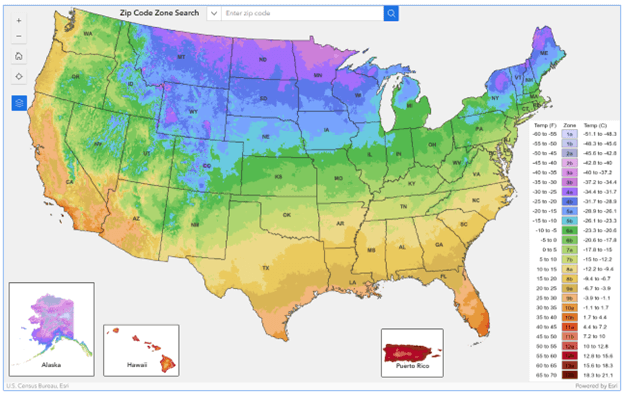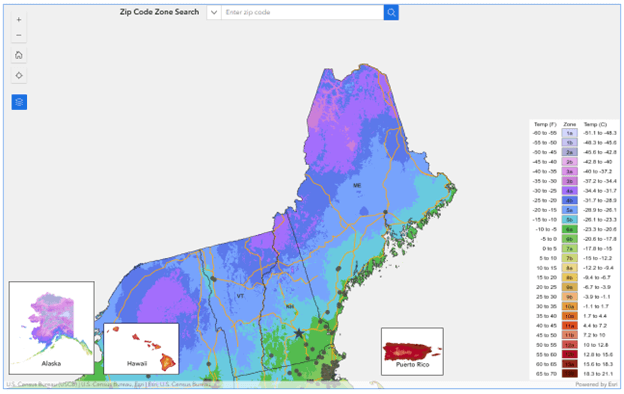Gardening Series – Maine’s Zones
Unlocking the Secrets of Maine’s Growing Zones
Grab your gardening gloves, and let’s explore Maine’s growing zones to better understand what to plant and where to plant it to ensure a bountiful bloom and healthy harvest. Once you understand the USDA plant hardiness zones, you’ll unlock a treasure map to gardening glory! So, let’s start there.
USDA Plant Hardiness Zones

The USDA (United States Department of Agriculture) plant hardiness zone map is a standardized system used to classify regions within a state based on their average annual minimum winter temperatures. The map divides the United States into numbered zones, each representing a 10-degree Fahrenheit difference in the average minimum temperature. These zones help determine which plants will most likely thrive based on their temperature tolerance.
Let’s say you live in Zone 5, which covers Maine’s northern and eastern interior areas. In Zone 5, the average annual minimum winter temperature falls between -10 (degrees)F and -20 (degrees)F (-23.3*C to -28.9*C). With this knowledge, you can select well-suited plants for your climate and cold tolerance. This might include hearty perennials like daylilies, shrubs like northern highbush blueberries, and cold-tolerant vegetables like kale and carrots.
You may ask, “Why does winter matter when I’m planting in the spring, summer, and fall?” Great question! An area’s winter climate matters because different plant species have varying levels of cold tolerance. Some plants can withstand freezing temps without damage, while others are more sensitive and may be injured or killed by frost. Selecting plants that can survive the colder temperatures is important for a successful garden, especially in Maine. Also, knowing the average dates of the first and last frosts helps determine the best time for planting different crops. Planting too early or too late can expose tender seedlings to frost damage, stunting their growth or even killing them.
Winter precipitation, such as snow and rain, contributes to soil moisture levels essential for plant growth. In regions with dry winters, supplemental watering may be necessary. On the flip side, excessive moisture from snowmelt can lead to waterlogged soil conditions that will harm plant roots. And don’t forget about frozen ground! Frozen soil makes it extremely hard for seedlings to establish themselves and expand their root systems because it is hard to penetrate.
Maine’s Zones
In Maine, our growing zones paint a colorful picture of our diverse landscape and temperatures, from coastal breezes to rugged mountains.
Zone 3 is where Maine’s coastal charm meets the warmth of its southern interior regions. While winters can still be cold, the proximity to the ocean moderates temperatures. Summers are typically cool to warm, with ample rainfall. Here are a few veggies that thrive in Zone 3.
- Broccoli: this is a cool season hardy crop that can withstand light frosts.
- Swiss Chard: a versatile green that grows strong in this temperate climate.
- Peas: Sugar snap, snow, or shelling; these cool-season legumes can be planted as soon as the ground can be worked in the spring.
Zone 4 covers Maine’s central and western interior regions. Winters here are colder than coastal regions, with more pronounced temperature fluctuations. Summers are generally warm but cooler than in southern parts of the state. Precipitation varies, with some areas experiencing drier conditions. Veggies that thrive here are:
- Potatoes: versatile and with great storage potential, should be a staple in Zone 4 gardens. Plant them early in the spring for a summer harvest.
- Kale: this leafy green is incredibly cold-hard and provides from spring through fall.
- Carrots: sweet and crunchy, best planted in loose, well-drained soil for straight, uniform roots.
Zone 5 is in Maine’s northern and eastern interior regions; winters are the coldest in the state, with temperatures dropping below freezing for extended periods. Summers are short and cool, with lower humidity levels. Precipitation is relatively consistent throughout the year. Veggies that do best here are:
- Brussels Sprouts are cold-tolerant cruciferous veggies that develop a sweeter flavor after exposure to light frosts in the fall.
- Beets: plant them early in the spring for a summer harvest of tender roots.
- Radishes: this is a quick crop and easy to grow, plant them in the early spring or late summer.
Choosing Plants for Your Zone
Above we’ve listed only a sliver of what vegetables can flourish in each zone. Armed with the knowledge of your zone, it is time to curate your garden. But where to begin? Take some time to research plants that are well-suited to your zone’s climate by looking for resources like gardening books, online forums and plant databases.
- The University of Maine Cooperative Extension offers a wealth of information for gardeners tailored to Maine’s growing conditions. www.extension.umaine.edu/gardening
- The Maine Native Plant Resource Guide highlights native plants suitable for various Zones in Maine. https://www.maine.gov/dacf/php/pesticides/yardscaping/landscape/plants.shtml
Understanding Maine’s growing zones is essential for successful gardening in our state. By knowing your zone and selecting plants accordingly, you can create a thriving garden, and don’t forget to aim for a diverse selection of plants that offer a range of colors, textures, and seasonal harvests. Don’t hesitate to experiment, too! Gardening is much about learning from mistakes as it is about the harvest. Happy Gardening!
